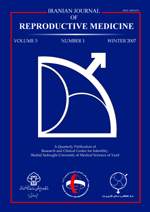
|
International Journal of Reproductive BioMedicine
Research and Clinical Center for Infertility, Shahid Sadoughi University of Medical Sciences of Yazd
ISSN: 1680-6433
EISSN: 1680-6433
Vol. 10, No. 5, 2012, pp. 435-440
|
 Bioline Code: rm12062
Bioline Code: rm12062
Full paper language: English
Document type: Research Article
Document available free of charge
|
|
|
International Journal of Reproductive BioMedicine, Vol. 10, No. 5, 2012, pp. 435-440
| en |
Effect of combined density gradient centrifugation on X- and Y- sperm separation and chromatin integrity
Esmaeilpour, Tahereh; Elyasi, Leila; Bahmanpour, Soghra; Ghannadi, Alireza; Monabbati, Ahmad; Dehghani, Farzaneh & Kazerooni, Marjaneh
Abstract
Background: It has been claimed that by using different washing methods, the sperms can be separated according to size, motility, density, chromosomal content and surface markings and charge. These methods also reduce sperm chromatin deficiencies and screen the sperms before applying in assisted reproduction techniques.
Objective: This study compared simple density gradient methods and a combined method with albumin density gradient and PureSperm separation (alb/PureSperm) for sex preselection by double fluorescence in situ hybridization (FISH) versus chromomycin A3 staining to determine chromatin integrity.
Materials and Methods: 30 normal semen samples were prepared with PureSperm, albumin gradients and alb/PureSperm. All samples were then stained by FISH and chromomycin A3. The results were compared with SPSS 11.5 and the Kruskal-Wallis test.
Results: The proportion of X-bearing spermatozoa by PureSperm separation (47.58±5.67) and Y-bearing spermatozoa by albumin gradient (46.13±3.83) methods were slightly higher than in putative normal sperm samples (1:1), but there were no significant differences in the X- or Y- bearing spermatozoa counts among the three methods. Albumin gradient separation tended to underestimate abnormal spermatozoa compared to PureSperm and combined alb/PureSperm.
Conclusion: Routine separation methods slightly enriched X- or Y- bearing spermatozoa, but the differences were not significant for clinical purposes. The combined alb/PureSperm method had no advantages for assessing sex ratio or chromatin integrity compared to simpler gradient methods.
Keywords
Albumin gradient, Double-labeled fluorescence in situ hybridization, Sperm separation, Sex ratio, Sperm chromatin.
|
| |
© Copyright 2012 - Iranian Journal of Reproductive Medicine
Alternative site location: http://www.ijrm.ir
|
|
